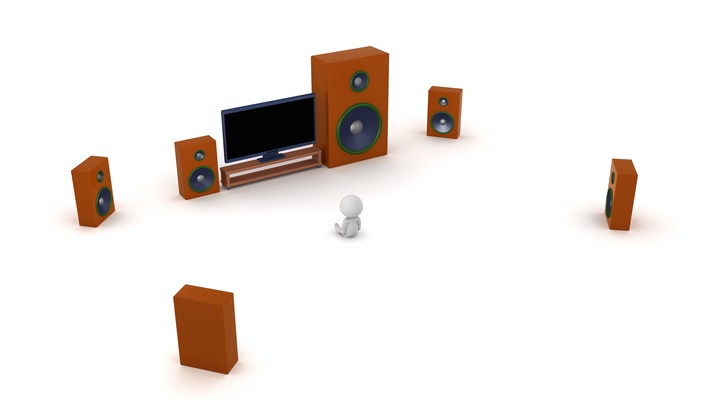If you are looking for a new experience in sound, then the surround system is the way to go. Surround sound system is an audio technology that makes it possible to hear all kinds of sound in three-dimensional spaces.
Its history dates back to the 1950s when people majorly used it in movie theaters and home entertainment systems. Today surround sound is the primary source of sound in most homes due to its ability to produce quality sound and improved user experience.
This can be achieved by positioning different speakers around the room, each with the ability to play at different audio strengths.
What Do Front-Height Speakers and Surround Back Mean?
In simple terms, front-height speakers refer to those located in front of the listener in a typical sitting room. These speakers produce the most superior and direct sound and should be aimed at the listener. You can position them above the main speaker or somewhere strategic within the room.
The Surround back, on the other hand, refers to those speakers located behind the listener. They help complement the front-height speakers and suppress the background noises.
Front Height Speakers vs Surround Back
Various factors ranging from the positioning, functioning, and price differentiate front-height speakers from the surround-back system. The front height speakers are, for example, positioned above the listener’s head while the Surround back sits to the side of the listener’s head.
The surround back speakers should be located behind the listener, while the front height speakers need to sit in front of the listener.
Front height speakers are cheaper than Surround audio sound systems. They generally cost half the price of surrounds even when they’re full range and only one-third or less the costs of surrounds if they are only front-firing height speakers.
The front height speaker plays back the same content as the FH channel, while the Surround back speaker plays different content from the surround backchannel.
While the surround back system’s primary role is to help fill in the background noises, front height speakers are meant to produce superior and prominent sounds.
The front height speaker’s sound is anchored by the center speaker, while the Surround back compliments that of the front height.
Front High vs Surround Back
Apart from the location, front and surround speakers differ in the following ways:
Front high speakers work to provide clear dialogues to enable viewers to understand what is being said. In contrast, Surround back speakers are meant to play the sound effects to the listener by surrounding them with discrete audio channels.
The frequency range between both speakers differs in that front high speakers are generally known to produce high-frequency sound waves( typically 1-3 kHz). However, Surround sound produces lower frequency sound waves( around 60Hz-100 Hz+).
Their placement is another differentiating factor. Front high speakers are complex. They must be placed at the listener’s ears height to minimize their effect against reverb reflections emanating from the walls and floors. Most of them are generally ceiling-mounted above the listener’s seating position. However, this is not the case with Surround back speakers as they only need to be placed in a line, starting from left to right behind the listener.
Front Height Speakers Placement
For best performance, the front-height speakers should be placed in the front stage’s upper left/right corners. They need to be as close to the ceiling as possible and tilted towards the listener.
Placing these speakers on the axis gives smooth continuity from the low frequency in the front main speakers to high frequency in front height speakers and vice versa.
While at it, ensure these speakers are safely separated for quality sounds. Having them too close will make the sound bumpy, while having them far apart will create a gap affecting their sound output. The safe distance to place your front-height speakers is roughly 8 feet apart.
As you place the front-height speakers, position them so that the tweeters are at the same height as your ears. This will help minimize the treble effect.
There are two central positions to choose from when you decide to place front-height speakers in the same place as your front main speakers. You can have them closer to front mains left and right or equidistant to front mains left and right.
Surround Back Speaker Placement
Before anything, it’s essential to understand that the quality of your speakers has a lot to do with how far you place them in your home. A good quality speaker will perform well regardless of how far it’s located from the main speakers in a living room.
To be on the safe side, have the Surround back speakers 6-10ft behind you or your room’s focal point and the tweeter 2ft above the ears when placed on a stand. If mounting the Surround back speakers, ensure they are 135-150 degrees from the room’s axis point. In both positions, the speakers should face forward to enhance clarity and quality sound.
Which Speaker Should Be Louder Between Front Height and Surround Back?
The Surround back speakers should be loud enough to enhance clarity in your home theater experience, for starters. When deciding which one should be louder between the two, you must keep the loudest front-height speakers.
Doing this makes it possible to grasp and understand conversations from your television and other sources with ease.
Also Read: Bass Reflex vs Acoustic Suspension: Major Differences and FAQs
In Conclusion
The best way to get surround sound is by investing in quality speakers. Also, be keen on where you place your speakers as it affects the overall sound quality. For instance, the Surround back speakers should be placed in mid-room positions to avoid the bass null problem if main speakers are placed on corners.


